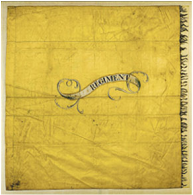See “The Grand Division Standard” (June 20, 2022) for a corrected and updated version of this post.Here are images of all three known Virginia regimental standards, shown together apparently for the first time. All three flags are in anonymous private collections but have been exhibited publicly. The flag in the middle belonged to the 8th Virginia. One of the other flags reportedly belonged to the 3rd Virginia. The faded rectangle in the center of the 8th Virginia flag is a consequence of light damage resulting from the way in which it was displayed for many years--it was originally one consistent (salmon) color. The flags follow an apparently standard design, but in varying colors. The color was the most important distinguishing characteristic of the flags, which were used to help troops stay organized in the smoke and confusion of battle.
The scrolls on the blue and yellow flags contain only the word "regiment." This suggests that they were made at the same time, with the intention that regiment numbers would be added when the colors had been assigned to the respective units. (The word "regiment" is not centered in the scrolls; space was retained to the left of the word on both flags.) The writing in the 8th Virginia's scroll is illegible because of light damage. The writing was retouched on the reverse side of the flag to say "VIII Virg Regt." An 1847 account in the Richmond Whig says the scroll contained the words "VIII Virga Regt." This sets it apart from the other two flags. This can be explained by the history of Virginia's Continental regiments. The 1st and 2nd regiments were authorized by the Virginia convention in 1775 for one-year enlistments. Seven more regiments were authorized in December of 1775 to be formed in 1776 for two-year enlistments, with the expectation that the 1st and 2nd would also continue with new or reenlisted men. Virginia expected all of these regiments to be taken into the Continental Army. Congress, however, initially only authorized seven Virginia Continental regiments. Despite being the first regiment to leave the Commonwealth in Continental service, the 8th drew the short straw and was not recognized immediately as anything other than a provincial (after July 4, "state") regiment. (The same was true of the small 9th regiment, which was created only for Eastern Shore defense.) At the urging of General Charles Lee, Congress later increased the number of authorized Virginia Continental regiments. One consequence of this complicated history may be that the 8th Virginia's regimental standard was not made at the same time as the other banners.
1 Comment
5/31/2018 10:24:32 am
Evidence suggests the blue and yellow flags are from the 2nd Virginia and the 7th Virginia regiments--but which flag connects with which regiment may be unknowable. At the time they were captured at Waxhaws, both regiments had absorbed other depleted regiments and they were both serving in a sort of ad hoc detachment under Col. Buford. More about them at the following link, but the description of them as "grand division" flags seems wrong. http://southerncampaign.org/newsletter/v3n678.pdf
Reply
Leave a Reply. |
Gabriel Nevilleis researching the history of the Revolutionary War's 8th Virginia Regiment. Its ten companies formed near the frontier, from the Cumberland Gap to Pittsburgh. Categories
All
Archives
June 2024
© 2015-2022 Gabriel Neville
|




 RSS Feed
RSS Feed